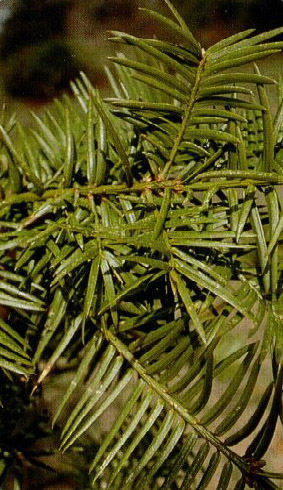- Torreya taxifolia
Taxobox
name = "Torreya taxifolia"
status = CR
status_system = iucn2.3

image_width = 240px
image_caption = Leaves of "Torreya taxifolia"
regnum =Plant ae
divisio =Pinophyta
classis = Pinopsida
ordo =Pinales
familia =Cephalotaxaceae
genus = "Torreya "
species = "T. taxifolia"
binomial = "Torreya taxifolia"
binomial_authority = Arn."Torreya taxifolia" is a rare and endangered species found in the
Southeastern United States at the state border region of northernFlorida , and southwestern Georgia. It is the type species of the genus "Torreya ". "Torreya taxifolia" is commonly known as the Florida Torreya, Stinking Yew, or Stinking Cedar although not closely related to the truecedar s.It became one of the first federally listed
endangered plant species in the United States in 1984; theIUCN lists the species as critically endangered. A survey conducted in 2000 estimates the population of "T. taxifolia" to be between 500 and 4000 individuals."Torreya taxifolia" is an
evergreen tree that may reach heights of up to 15 to 20 meters. The trees are conical in overall shape, with whorled branches and stiff sharp pointed, needle-like leaves 2-3.5 cm long and 3 mm broad. The male (pollen ) cones are 5-7 mm long, grouped in lines along the underside of a shoot. The female (seed ) cones are single or grouped 2-5 together on a short stem; minute at first, they mature in about 18 months to adrupe -like structure with the single large nut-like seed 2-3.5 cm long surrounded by a fleshy covering, dark green to purple at full maturity in the fall. The leaves and cones have a strongly pungent resinous odor when crushed, leading to its popular names "Stinking Yew" and "Stinking Cedar".In the 19th century the tree was harvested for wood that was used as fenceposts, shingles, furniture and as a fuel for riverboats on the
Apalachicola River . Today the species is restricted to bluffs andravine s withinTorreya State Park , along the east bank of the Apalachicola River in theFlorida Panhandle and immediate adjacent southernmost Georgia. Most stands are composed of immature trees of less than 2 meters tall. The population of mature trees crashed in the 1950s, possibly due to the introduction of a still uncharacterised fungal disease. Up to 11 species of fungi attack "T. taxifolia", including species of "Physalospora" and "Macrophoma".Fungicide treatment has been shown to be an effective treatment for fungal infection, with plants showing renewed growth after treatment. Recovery of the species may be inhibited by post-glacial global warming, as it is best adapted to the cooler, moister climate found in this area during the lastice age . It may not have been able to move north in the post-glacial warming, due to poor dispersal abilities.Cultivated specimens are however growing very well in cooler climates in the
Appalachian Mountains , in northern Georgia and at theBiltmore Gardens inAsheville, North Carolina where it is regenerating naturally. It has been proposed that the best course to save the species from extinction is to plant groves of it in these areas.Assisted Migration for "Torreya taxifolia" (from Florida to S. Appalachians)
[http://www.torreyaguardians.org Torreya Guardians] is a volunteer group of citizen-naturalists, botanists, ecologists, and landowners that has formed with the mission of finding and implementing ways outside the jurisdiction of The Endangered Species Act to use private seed stock to establish groves of "Torreya taxifolia" trees in the southern Appalachians and points north, such that viable seeds will then be available for
rewilding this tree onto private lands far enough north and at high enough elevations to resist the diseases already brought about byglobal warming in its endemic habitat in Florida. The idea is that "Torreya taxifolia" for some reason was unable to migrate on its own back north from its "ice age pocket refuge" in northern Florida, and that assisted migration will thus help this species return to its traditional interglacial range in the Appalachian Mountains. The January 2007 issue of [http://conbio.net/cip/article81whe.cfm "Conservation Magazine"] depicted "Torreya taxifolia" as the lead candidate for assisted migration owing to global warming. The May/June 2008 issue of [http://www.orionmagazine.org/index.php/articles/article/2966/ "Orion Magazine"] includes an in-depth review of the controversy pro and con assisted migration for Torreya taxifolia.References and external links
* Listed as Critically Endangered (CR A1c v2.3)
* Schwartz, M.W. et al. 2000. Estimating the magnitude of decline of the Florida torreya ("Torreya taxifolia" Arn.). "Biological Conservation" 95:77-84
*U.S. Fish and Wildlife Service. 1984. [http://ecos.fws.gov/docs/frdocs/1984/84-1722.pdf "Federal Register" (pdf)]
* U.S. Forestry Service. " [http://www.fs.fed.us/database/feis/plants/tree/tortax/ Torreya taxifolia] "
*Fox, Douglas. 2007. [http://www.conbio.org/cip/article81whe.cfm When worlds collide] . "Conservation" 8(1):28-34.*Nijhuis, Michelle. 2008. [http://www.orionmagazine.org/index.php/articles/article/2966/ Taking Wildness in Hand: Rescuing Species] . "Orion Magazine" May/June 2008, pp. 64-78.
* [http://www.torreyaguardians.org/rewilding.html Proposals for re-establishment] .
* [http://www.efloras.org/florataxon.aspx?flora_id=1&taxon_id=220013607 Flora of North America: "Torreya taxifolia"] [http://www.efloras.org/object_page.aspx?object_id=5426&flora_id=1 Range
]
Wikimedia Foundation. 2010.
